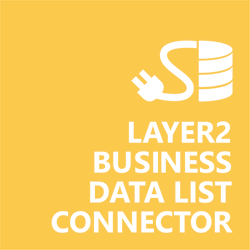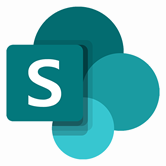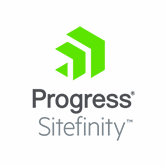Keep your SharePoint on-premises in sync with 100+ external sources. Register, download and try today.
Sitefinity Data Integration with SharePoint
Sitefinity data sources like posts, friend lists and followers can be integrated codeless with SharePoint on-premises using the Layer2 Business Data List Connector. In case you are looking for Online data integration, you will find the right tool here.
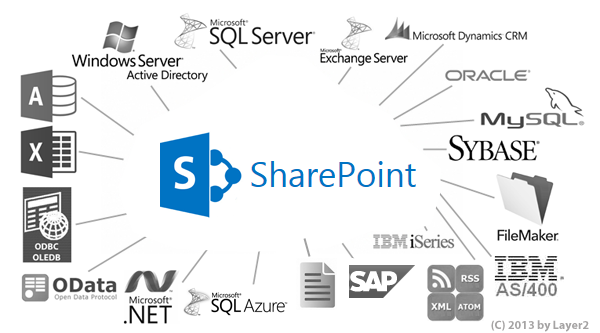
Benefits of Sitefinity Integration in SharePoint
- Very easy to setup in a few minutes: Create a SharePoint list, click "Connect to external data source" in the list settings, select the data provider, enter connection settings and data query as shown below. That's it.
- No changes in the ODBC data source required: No programming, no additional tools.
- Connected list data always up-to-date: The connected ODBC data query updates automatically in background (via SharePoint Timer Job), or alternatively, on-demand (Action Menu / Ribbon Button, URL, via workflow, API).
- Well-known BCS "external list" issues and limitations are completely solved: ALL list features are to you. Views, sorting and grouping, filters, calculated fields, search, managed metadata. Lookups, additional columns and attachments can be created as normal. All kind of lists can be used, e.g. contacts, tasks, calendar, or custom lists. You can take external data offline via Outlook.
- Workflows and notifications on external data change: List workflows and change notifications per RSS or email can be used to take business actions in SharePoint, when external ODBC data records are changed.
- Application logging, reporting, and notifications: A SharePoint list is used to store settings and log information. SharePoint item versioning and workflows can be used to manage reporting and notifications. Direct notification per email in case of errors is supported as well.
- Highest Security, best performance, easy to maintain: SharePoint Secure Store can be used to store security relevant configuration information safely in one central place. Users are working with the SharePoint lists as an external data cache with highest security and performance. Large data sources can be synchronized.
- 100+ more external systems supported: Layer2 Data Providers included (e.g. for external SharePoint or Office 365, Exchange, Dynamics ERP/CRM, OData, XML/RSS, SOAP), vendor specific data providers can be used (e.g. SQL Server Oracle, MySQL etc.), 3rd party data providers also supported, e.g. for custom ERP/CRM, Facebook or Twitter. See here for supported systems and applications.
Sitefinity Specific SharePoint List Configuration Settings
In the SharePoint General List Settings click "Connect to external data source". In the BDLC form, the data source must be configured as follows to connect to Sitefinity using the .Net Framework Data Provider for SqlServer.
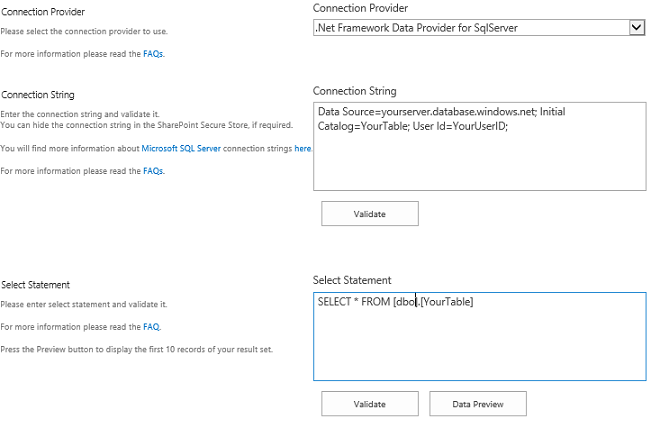
Figure 3: Example connection configuration to connect Sitefinity via Layer2 Business Data List Connector.
Please note the following specific settings:
- Select the .Net Framework Data Provider for SqlServer to connect.
- You can use a connection string like this to connect:
Data Source=yourserver.database.windows.net; Initial Catalog=YourTable; User Id=YourUserID; - You can map your data fields to specific external source fields in the Layer2 Cloud Connector. Please take care about data types (simple type conversions are supported).
- No installation or changes are required at the data source or data destination.
- You can make use of all SQL queries your data provider supports. You can also use stored procedures that returns records, exec myStoredProcedure().
- The primary key is normally set automatically, if available.
- You can use the connection for uni- or bi-directional synchronization. Several replication conflict solution strategies are offered.
- No need to open your local network for access from outside.
- Bi-directional sync is generally supported. You query must be updatable for
this (note that most joins are not). You will also need write access rights for
this.
Sitefinity Connection Details
Provider:
.Net Framework Data Provider for
SqlServer
Connection string sample:
Data
Source=yourserver.database.windows.net; Initial Catalog=YourTable; User
Id=YourUserID;
Select Statement samples:
SELECT * from
[dbo].[YourTable]
Ready for next steps?

